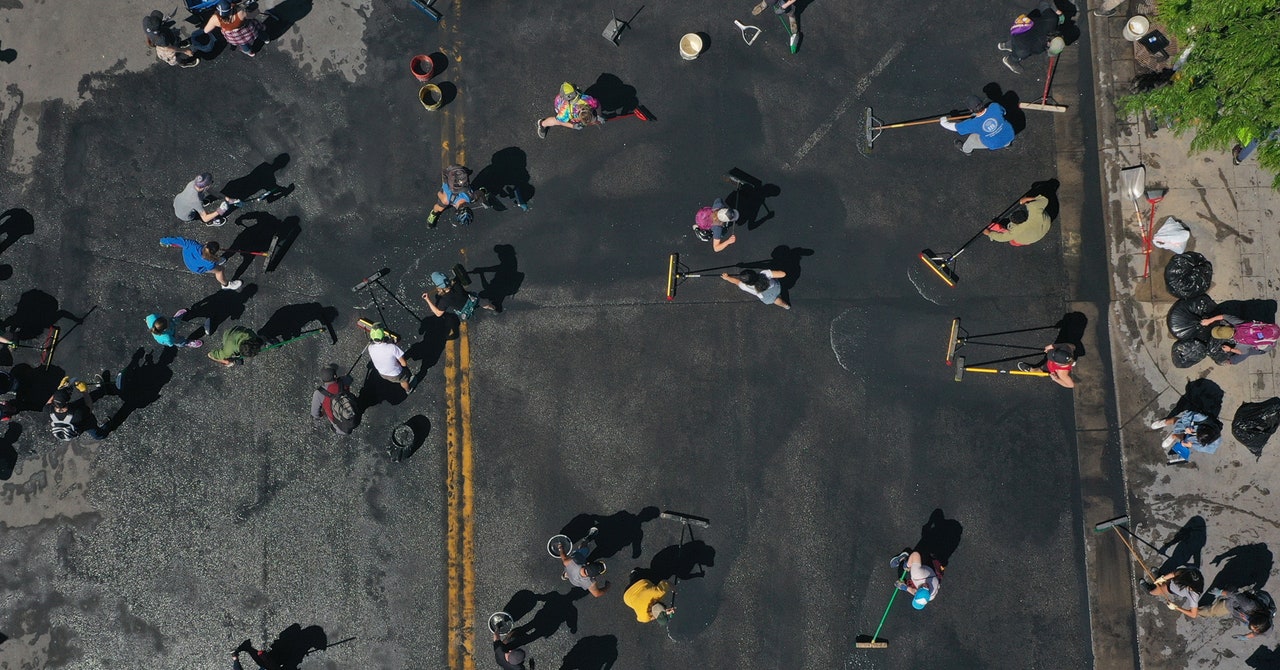On Saturday afternoon, under a cloudless Minneapolis sky, thousands of people flocked to a 50-block stretch of Lake Street, where for the previous three days, mass protests over the police killing of George Floyd sparked riots and violent standoffs with police and National Guard. Some came with brooms and buckets. Some drove trucks full of freshly cut plywood and portable drills for boarding up the businesses that were left. Many carried hand-painted signs saying “Stop killing black people” and “Justice for George.” Almost everyone wore a mask. And everywhere you looked, people were pointing cell phones—capturing protesters chanting, citizens sweeping up broken glass, and buildings still smoldering for audiences on Twitter, Instagram, and Facebook to see.
At a gathering a few blocks to the south in Martin Luther King Jr. Park, the ground rules were very different: no livestreaming, no social media posts, only share things directly with people you trust. It may have seemed a bit paranoid to the 300 people, mostly white families and retirees, who had shown up to participate in a neighborhood defense planning meeting. But then again, scores of shops, restaurants, and community bulidings in the city had been damaged or set on fire in the past 24 hours. And they had reason to believe that this night would be even worse.
That morning, Minnesota governor Tim Walz had claimed during a press conference that highly organized outside groups, including white supremacists and drug cartels, were believed to be part of the protests that had turned violent in South Minneapolis, leaving hundreds of buildings damaged and burned in recent days. There were also local reports of armed white men roaming the area in out-of-state vehicles carrying symbols associated with a variety of online fringe groups with different agendas, including far-right militia, white supremacists, and anti-government firearm enthusiasts with pro-protester/anti-police politics.
If the threat of the coronavirus pandemic had forced Minneapolis residents to interact with other people almost exclusively through screens since mid-March, the threat of armed arsonists intent on starting a race war galvanized them into action IRL. They were worried that any organizing information they’d put on the internet could be seen—and therefore disrupted—by people who might mean them harm. So to air-gap these plans from would-be infiltrators, many organizing efforts went analogue, returning to tactics reminiscent of a pre-internet era. All day long, all across the city, citizens met in parks and in front of community centers to build phone trees (remember those?), form block peacekeeping patrols, and draw up plans to defend their homes and businesses from potential nighttime marauders.
The night before—Friday—when the city’s fourth day of protests had become a fiery free-for-all up and down Lake Street, Raquel Sidie-Wagner had been at home, eight blocks south, watching the news, scrolling Twitter, and feeling terrified about what might come up to her door. “I realized the city is not prepared for this,” she said. “And we’re all sitting scared and alone in our houses. If the only thing we can really do is look out for each other then we might as well be proactive about it.” And at first, she had turned to the internet to do something about it. At 2: 30 in the morning, while the flames in Minneapolis burned bright enough to be seen more than 30 miles away in Hudson, Wisconsin, Sidie-Wagner created an event in her King Field neighborhood’s closed Facebook group for Saturday afternoo
Read More

